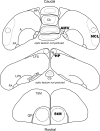Constitutive gene expression differs in three brain regions important for cognition in neophobic and non-neophobic house sparrows (Passer domesticus)
- PMID: 35536842
- PMCID: PMC9089922
- DOI: 10.1371/journal.pone.0267180
Constitutive gene expression differs in three brain regions important for cognition in neophobic and non-neophobic house sparrows (Passer domesticus)
Abstract
Neophobia (aversion to new objects, food, and environments) is a personality trait that affects the ability of wildlife to adapt to new challenges and opportunities. Despite the ubiquity and importance of this trait, the molecular mechanisms underlying repeatable individual differences in neophobia in wild animals are poorly understood. We evaluated wild-caught house sparrows (Passer domesticus) for neophobia in the lab using novel object tests. We then selected a subset of neophobic and non-neophobic individuals (n = 3 of each, all females) and extracted RNA from four brain regions involved in learning, memory, threat perception, and executive function: striatum, caudal dorsomedial hippocampus, medial ventral arcopallium, and caudolateral nidopallium (NCL). Our analysis of differentially expressed genes (DEGs) used 11,889 gene regions annotated in the house sparrow reference genome for which we had an average of 25.7 million mapped reads/sample. PERMANOVA identified significant effects of brain region, phenotype (neophobic vs. non-neophobic), and a brain region by phenotype interaction. Comparing neophobic and non-neophobic birds revealed constitutive differences in DEGs in three of the four brain regions examined: hippocampus (12% of the transcriptome significantly differentially expressed), striatum (4%) and NCL (3%). DEGs included important known neuroendocrine mediators of learning, memory, executive function, and anxiety behavior, including serotonin receptor 5A, dopamine receptors 1, 2 and 5 (downregulated in neophobic birds), and estrogen receptor beta (upregulated in neophobic birds). These results suggest that some of the behavioral differences between phenotypes may be due to underlying gene expression differences in the brain. The large number of DEGs in neophobic and non-neophobic birds also implies that there are major differences in neural function between the two phenotypes that could affect a wide variety of behavioral traits beyond neophobia.
Conflict of interest statement
The authors have declared that no competing interests exist.
Figures




Similar articles
-
Novel objects alter immediate early gene expression globally for ZENK and regionally for c-Fos in neophobic and non-neophobic house sparrows.Behav Brain Res. 2022 Jun 25;428:113863. doi: 10.1016/j.bbr.2022.113863. Epub 2022 Mar 26. Behav Brain Res. 2022. PMID: 35351483
-
No Guts About It: Captivity, But Not Neophobia Phenotype, Influences the Cloacal Microbiome of House Sparrows (Passer domesticus).Integr Org Biol. 2022 Mar 11;4(1):obac010. doi: 10.1093/iob/obac010. eCollection 2022. Integr Org Biol. 2022. PMID: 35505795 Free PMC article.
-
No, you go first: phenotype and social context affect house sparrow neophobia.Biol Lett. 2020 Sep;16(9):20200286. doi: 10.1098/rsbl.2020.0286. Epub 2020 Sep 2. Biol Lett. 2020. PMID: 32871090 Free PMC article.
-
Exploration of A novel environment is not correlated with object neophobia in wild-caught house sparrows (Passer domesticus).Behav Processes. 2023 Aug;210:104913. doi: 10.1016/j.beproc.2023.104913. Epub 2023 Jul 3. Behav Processes. 2023. PMID: 37406866
-
Patterns of predator neophobia: a meta-analytic review.Proc Biol Sci. 2017 Aug 30;284(1861):20170583. doi: 10.1098/rspb.2017.0583. Proc Biol Sci. 2017. PMID: 28835552 Free PMC article. Review.
Cited by
-
A novel finding on the sex-dependent role of BDNF and GSK-3beta in the medial prefrontal cortex in pain threshold changes in a rat model of fear conditioning with respect to the effect of extinction and the time period after conditioning.Exp Brain Res. 2025 Aug 18;243(9):196. doi: 10.1007/s00221-025-07145-1. Exp Brain Res. 2025. PMID: 40824546
-
Neurogenomic landscape associated with status-dependent cooperative behaviour.Mol Ecol. 2025 Aug;34(15):e17327. doi: 10.1111/mec.17327. Epub 2024 Mar 21. Mol Ecol. 2025. PMID: 38511765 Free PMC article.
-
What made us "hunter-gatherers of words".Front Neurosci. 2023 Feb 9;17:1080861. doi: 10.3389/fnins.2023.1080861. eCollection 2023. Front Neurosci. 2023. PMID: 36845441 Free PMC article.
References
-
- Greggor AL, Thornton A, Clayton NS. Neophobia is not only avoidance: improving neophobia tests by combining cognition and ecology. Current Opinion in Behavioral Sciences. 2015;6:82–9. doi: 10.1016/j.cobeha.2015.10.007 - DOI
-
- Greenberg R, Mettke-Hofmann C. Ecological aspects of neophobia and neophilia in birds. In: Nolan V, Thompson CF, editors. Current Ornithology. 16. Boston, MA: Springer; 2001.
-
- Herborn KA, Macleod R, Miles WTS, Schofield ANB, Alexander L, Arnold KE. Personality in captivity reflects personality in the wild. Animal Behaviour. 2010;79(4):835–43. 10.1016/j.anbehav.2009.12.026. - DOI
Publication types
MeSH terms
LinkOut - more resources
Full Text Sources
Miscellaneous

